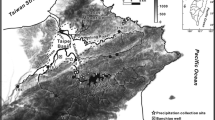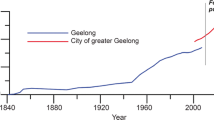Abstract
The Wudalianchi scenic area in NE China has been named an UNESCO “Global Geopark” and “Biosphere Reserve.” During this investigation, the sources of nitrate and the hydrologic system through which it is dispersed were assessed using geochemical data and a multiple isotopic approach. The cold waters from the south and north springs originated from the deep subsurface. Isotopically, these waters exhibited relatively negative δD and δ18O values and nitrate in the water was substantially depleted 15N, suggesting that the mineral water was primarily derived from depth. Lakes within the Wudalianchi region were primarily composed of water from these deep mineral springs and precipitation. Chemical fertilizers were the primary source of nitrate to the Wudalianchi lakes. Groundwater was found in shallow mineral springs and wells plotted above the local meteoric water line, implying that shallow groundwater was primarily derived from precipitation. Elevated concentrations of nitrate in shallow mineral springs and well waters during the summer, autumn, and winter suggest that shallow groundwater within the Yaoquan volcanic area was also polluted by nitrate from human activities. Denitrification of shallow groundwater is slow, reducing the potential for “self-remediation”. The concentration data are supported by nitrogen (N) isotope data; wells and springs exhibited N isotopic ratios between − 5‰ and + 5‰ (typical of fertilizers and precipitation) and exhibited higher oxygen (O) isotope values than water in the Wudalianchi lakes. These relationships suggest that nitrate in shallow mineral springs, wells, and lakes near the Yaoquan volcano was derived from the mixing of chemical fertilizers with local summer rainfall.








Similar content being viewed by others
References
Andersson KK, Hooper AB (1983) O2 and H2O are each the source of one O in NO2 − produced from NH3 by Nitrosomonas: 15N−NMR evidence. FEBS Lett 164:236–240. https://doi.org/10.1016/0014-5793(83)80292-0
Aravena R, Evans ML, Cherry JA (2010) Stable isotopes of oxygen and nitrogen in source identification of nitrate from septic systems. Ground Water 31:180–186. https://doi.org/10.1111/j.1745-6584.1993.tb01809.x
Böhlke JK, Denver JM (1995) Combined use of groundwater dating, chemical and isotopic analyses to resolve the history and fate nitrate contamination in two agricultural watersheds, Atlantic Coastal Plain, Maryland. Water Resour Res 31(9):2319–2339. https://doi.org/10.1029/95WR01584
Böttcher J, Strebel O, Voerkelius S, Schmidt HL (1990) Using isotope fractionation of nitrate nitrogen and nitrate oxygen for evaluation of denitrification in a sandy aquifer. J Hydrol 114:413–424. https://doi.org/10.1016/0022-1694(90)90068-9
Burns DA, Kendall C (2002) Analysis of δ15N and δ18O to differentiate NO3 - sources in runoff at two watersheds in the Catskill Mountains of New York. Water Resour Res 38:9-1–9-11. https://doi.org/10.1029/2001WR000292
Clark ID, Fritz P (1997) Environmental isotopes in hydrogeology. Lewis Publishers, New York
Craig H (1961) Isotopic variation in meteoric waters. Science 133:1702–1703
Dansgaard W (1964) Stable isotopes in precipitation. Tellus 16:436–468
Du JG, Li SQ, Zhao Y et al (1999) Geochemical characteristics of gases from the Wudalianchi volcanic area, Northeastern China. Acta Geol Sin (English Edition) 73:225–229. https://doi.org/10.1111/j.1755-6724.1999.tb00830.x
Finlay JC, Sterner RW, Kumar S (2007) Isotopic evidence for in-lake production of accumulating nitrate in Lake Superior. Ecol Appl 17:2323–2332. https://doi.org/10.1890/07-0245.1
Guo W, Huo S, Xi B, Zhang J, Wu F (2015) Heavy metal contamination in sediments from typical lakes in the five geographic regions of China: distribution, bioavailability, and risk. Ecol Eng 81:243–255. https://doi.org/10.1016/j.ecoleng.2015.04.047
Gui Z, Xue B, Yao S, Zhang F, Yi S (2012) Catchment erosion and trophic status changes over the past century as recorded in sediments from Wudalianchi Lake, the northernmost volcanic lake in China. Quatern Int 282:163–170. https://doi.org/10.1016/j.quaint.2012.05.012
Han G, Lv P, Tang Y, Song Z (2017) Spatial and temporal variation of H and O isotopic compositions of the Xijiang River system, Southwest China. Isot Environ Health Stud 1:137–146. https://doi.org/10.1080/10256016.2017.1368507
Hiscock KM, Lloyd JW, Lerner DN (1991) Review of natural and artificial denitrification of groundwater. Water Res 25(9):1099–1111. https://doi.org/10.1016/0043-1354(91)90203-3
Kang P, Xu S (2016) The impact of mariculture on nutrient dynamics and identification of the nitrate sources in coastal waters. Environ Sci Pollut R 23(2):1300–1311. https://doi.org/10.1007/s11356-015-5363-0
Kellman L, Hillaire-Marcel C (1998) Nitrate cycling in streams: using natural abundances of NO3 −-δ15N to measure in-situ denitrification. Biogeochemistry 43:273–292. https://doi.org/10.1023/A:1006036706522
Kendall C, Elliott EM, Wankel SD (2007) Tracing anthropogenic inputs of nitrogen to ecosystems. Stable isotopes in ecology and environmental science, Second Edition 375–449. https://doi.org/10.1002/9780470691854.ch12
Kendall C, McDonell JJ e (1998) Isotope tracers in catchment hydrology. Elsevier Science, Amsterdam
Kendall C (1998) Tracing nitrogen courses and cycling in catchments. Isotope Tracers in Catchment Hydrology Chapter 16. https://doi.org/10.1016/B978-0-444-81546-0.50023-9
Kool DM, Wrage N, Oenema O, van Kessel C, van Groenigen JW (2011) Oxygen exchange with water alters the oxygen isotopic signature of nitrate in soil ecosystems. Soil Biol Biochem 43:1180–1185. https://doi.org/10.1016/j.soilbio.2011.02.006
Lake JL, McKinney RA, Osterman FA, Pruell RJ, Kiddon J, Ryba SA, Libby AD (2001) Stable nitrogen isotopes as indicators of anthropogenic activities in small freshwater systems. Can J Fish Aquat Sci 58:870–878
Li SL, Liu CQ, Li J, Liu X, Chetelat B, Wang B, Wang F (2010) Assessment of the sources of nitrate in the Changjiang River, China using a nitrogen and oxygen isotopic approach. Environ Sci Technol 44:1573–1578. https://doi.org/10.1021/es902670n
Li SL, Liu CQ, Li J, Xue Z, Guan J, Lang Y, Ding H, Li L (2013) Evaluation of nitrate source in surface water of southwestern China; based on stable isotopes. Environ Earth Sci 68:219–228. https://doi.org/10.1007/s12665-012-1733-9
Li SL, Yue FJ, Liu CQ et al (2015) The O and H isotope characteristics of water from major rivers in China. Chin J Geochem 34:28–37. https://doi.org/10.1007/s11631-014-0015-5
Liang LE, Li C, Shi XH et al (2017) Characteristics of hydrogen and oxygen isotopes of surface and groundwater and the analysis of source of lake water in Hulun Lake Basin, Inner Mongolia. Wetland Sci-China 15(3):385–390 (in Chinese with an English abstract)
Liang XJ, Xiao CL, Sheng HX et al (2007) Migration and transformation of ammonia-nitrite-nitrates in groundwater in the City of Jilin. J Jilin University (Earth Science Edition) 37(2):335–345 (in Chinese with an English abstract)
Liu CQ, Li SL, Lang YC, Xiao HY (2006) Using δ15N- and δ18O-values to identify nitrate sources in karst ground water, Guiyang, Southwest China. Environ Sci Technol 40:6928–6933. https://doi.org/10.1021/es0610129
Mcilvin MR, Altabet MA (2005) Chemical conversion of nitrate and nitrite to nitrous oxide for nitrogen and oxygen isotopic analysis in freshwater and seawater. Anal Chem 77:5589–5595. https://doi.org/10.1021/ac050528s
Mengis M, Walther U, Bernasconi SM, Wehrli B (2001) Limitations of using delta 18O for the source identification of nitrate in agricultural soils. Environ Sci Technol 35:1840–1844. https://doi.org/10.1021/es0001815
Nestler A, Berglund M, Accoe F, Duta S, Xue D, Boeckx P, Taylor P (2011) Isotopes for improved management of nitrate pollution in aqueous resources: review of surface water field studies. Environ Sci Pollut R. 18(4):519–533. https://doi.org/10.1007/s11356-010-0422-z
Nikolenko O, Jurado A, Borges AV et al (2017) Isotopic composition of nitrogen species in groundwater under agricultural areas: a review. Sci Total Environ. https://doi.org/10.1016/j.scitotenv.2017.10.086
Pardo LH, Kendall C, Pett-Ridge J, Chang CCY (2004) Evaluating the source of streamwater nitrate using δ15N and δ18O in nitrate in two watersheds in New Hampshire, USA. Hydrol Process 18:2699–2712. https://doi.org/10.1002/hyp.5576
Rozanski K, Araguas-Araguas L, Gonfiantini R (1993) Isotope patterns in modern global precipitation. In: Swart PK et al (eds) Climate change in continental isotope records, geophysical monograph series, vol 78. AGU, Washington, pp 1–36
Sun RB, Du JG (1998) The hydro-geochemical background of the Wudalianchi volcanic area. Bulletin mineral. Petrol Geochem 17(3):150–155 (in China with an English abstract)
Wang XZ (2001a) The new explanation of the cause of Wudalianchi mineral water. Heilongjiang Geol 1:27–39 (in Chinese with an English abstract)
Wang YP (2001b) Evaluation and discussion on the primary mineral water resources of Yaoquanshan in Wudalianchi. Heilongjiang Geol 4:95–107 (in Chinese with an English abstract)
Xiao HY, Liu CQ (2002) Sources of nitrogen and sulfur in wet deposition at Guiyang, southwest China. Atmos Environ 36:5121–5130. https://doi.org/10.1016/S1352-2310(02)00649-0
Xiao K, Shen LC, Wang P (2014) Hydrogen and oxygen isotopes of lake water and geothermal spring water in arid area of south Tibet. Environ Sci 35(8):2952 (in China with an English abstract)
Xing G, Cao Y, Shi S et al (2001) N pollution sources and denitrification in waterbodies in Taihu Lake region. Sci China Ser B 44:304–314. https://doi.org/10.1007/BF02879621
Xue D, Botte J, De Baets B, Accoe F, Nestler A, Taylor P, Van Cleemput O, Berglund M, Boeckx P (2009) Present limitations and future prospects of stable isotope methods for nitrate source identification in surface and groundwater. Water Res 43:1159–1170. https://doi.org/10.1016/j.watres.2008.12.048
Yan L, Hu H, Zhang S, Chen P, Wang W, Li H (2017) Arsenic tolerance and bioleaching from realgar based on response surface methodology by Acidithiobacillus ferrooxidans, isolated from Wudalianchi volcanic lake, northeast China. Electron J Biotechnol 25(C):50–57. https://doi.org/10.1016/j.ejbt.2016.11.007
Yue FJ, Li SL, Liu CQ, Zhao ZQ, Hu J (2013) Using dual isotopes to evaluate sources and transformation of nitrogen in the Liao River, northeast China. Appl Geochem 36:1–9. https://doi.org/10.1016/j.apgeochem.2013.06.009
Yue FJ, Liu CQ, Li SL, Zhao ZQ, Liu XL, Ding H, Liu BJ, Zhong J (2014) Analysis of δ15N and δ18O to identify nitrate sources and transformations in Songhua River, Northeast China. J Hydrol 519:329–339. https://doi.org/10.1016/j.jhydrol.2014.07.026
Yue FJ, Li SL, Liu CQ, Lang YC, Ding H (2015) Sources and transport of nitrate constrained by the isotopic technique in a karst catchment: an example from southwest China. Hydrol Process 29:1883–1893. https://doi.org/10.1002/hyp.10302
Yue FJ, Li SL, Liu CQ, Zhao ZQ, Ding H (2017) Tracing nitrate sources with dual isotopes and long term monitoring of nitrogen species in the Yellow River, China. Sci Rep-UK 7(1):8537. https://doi.org/10.1038/s41598-017-08756-7
Zeng Y, Yang C, Wang XY et al (2017) Application of principal component analysis to parse the source of heavy metals in surface sediments of volcano dammed lake in Wudalianchi. Environ Dev 42:168–170 (in Chinese with an English abstract)
Zhang YD, Wang YP, Li JZ et al (1988) Genesis study of mineral water in Yaoquan Mountain in Wudalianchi. Hydrogeol Eng 4:28–31 (in Chinese)
Zheng MF, Hu WJ, Qiu YS et al (2017) N2O preconcentration device upgraded for Gasbench || -IRMS analyzing N and O isotopes of seawater nitrate. J Appl Oceanography 36:135–142 (in Chinese with an English abstract)
Acknowledgements
We gratefully acknowledge Prof. Philippe Garrigues and two anonymous reviewers for their thoughtful and constructive comments.
Funding
This work was supported financially by National Natural Science Foundation of China (Grant No. 41472237), Jilin University Postdoctoral Research Start-up Funds (801171050425), Liaoning Innovation Team Project (No. LT2015017) and Research Programs of Heilongjiang Land and Resources Department.
Author information
Authors and Affiliations
Corresponding author
Additional information
Responsible editor: Philippe Garrigues
Highlights
1. Agricultural non-point source nitrate pollution is a serious problem in the Wudalianchi scenic area, a “Global Geopark” and “Biosphere Reserve.”
2. Geochemical data were combined with multiple stable isotopes to analyze the source and interconnections between lake, spring, and groundwaters.
3. Anthropogenic pollutants, particularly chemical fertilizers, were the primary sources of nitrate to the lakes as well as shallow mineral springs and wells.
4. The chemistry of cold deep mineral spring waters primarily reflected water-rock interactions at depth and, in combination with precipitation, served as the primary source of water to the lakes.
Rights and permissions
About this article
Cite this article
Zhang, H., Yang, Y., Zou, J. et al. The sources and dispersal of nitrate in multiple waters, constrained by multiple isotopes, in the Wudalianchi region, northeast China. Environ Sci Pollut Res 25, 24348–24361 (2018). https://doi.org/10.1007/s11356-018-2490-4
Received:
Accepted:
Published:
Issue Date:
DOI: https://doi.org/10.1007/s11356-018-2490-4




